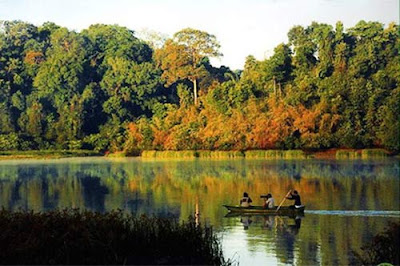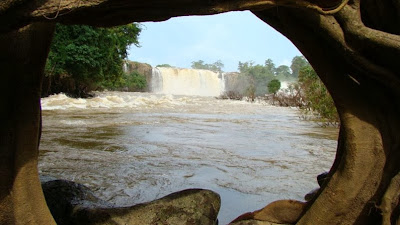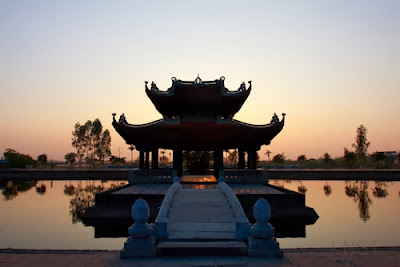Dong Nai Province, Vietnam travel guides
Capital: Bien Hoa City
Ethnic groups: Viet (Kinh), Hoa, Xtieng, Cho Ro, Cham Highlights: Cat Tien National Park, Tri An Waterfall, Hang Gon Tomb, Tan Trieu Pomelo Village
Where to travel around:
Tran Bien Temple of Literature
The temple of literature was built in the late 17th century in Buu Long Ward, Bien Hoa City. Like the Temple of Literature in Ha Noi, Tran Bien was a university for students in the South. This structure showed the tradition of encouraging and enjoying study of southerners. In December 1861 when French troops occupied Bien Hoa, this temple was destroyed. It was rebuilt in the late 20th century so that the generations of today understand the history of Vietnamese education. The new Tran Bien Temple of Literature has architectural style of the Temple of Literature in Ha Noi.
Annually, there takes place two major events in the temple. They are Xuan Vinh in the 2nd lunar month and Thu Vinh in the 8th lunar month.
Tan Trieu Pomelo Ecological VillageTan Trieu Pomelo Ecological Village belongs to Tan Binh Commune, Vinh Cuu District, 25km from Bien Hoa City, is well known for its many pomelo orchards. Visitors are likely to be offered fruit samples to taste the variety of pomelos available at Tan Trieu.
The thanh tra pomelo is easily recognizable for its mild sweetness and sour taste. Residents of Ho Chi Minh City often go on picnics to Tan Trieu Pomelo Village.
Buu Long Tourist Park
Buu Long Tourist Park covers some 84 ha on the outskirts of Bien Hoa City, 6km from city centre, 30km from Ho Chi Minh City. It is a landscape with mountains, pagodas and a large lake, some people excessively call Ha Long Bay in miniature".
The Tourist Park embraces Long An Lake, an artificial reservoir covering an area of more than 10 ha. The crystal clear lake has plenty of large rocks that have the look of small islets.
Boats will carry visitors around the lake, and to an islet in the middle of the lake. Climbing 35m to the top of the islet, you will watch scenery of zocks and trees make the surroundings cool and pleasant, and help visitors take a comfortable rest after climbing nearly 100 steps.
Close to the lake is Buu Long mount, which reflects itself on the lake, creating beautiful scenery. Buu Phong Pagoda was built in the 17th century on the mountain. Nearly 100 steps must be climbed to reach the pagoda. The pagoda was only a thatch roofed hut at first, and was renovated and enlarged in 1829. More renovations have been made recently.
Many ancient artifacts are left at the pagoda, including clothes dating back to the Nguyen Dynasty, and lying Buddha statues. Around the pagoda are several towers, large rocks of strange shapes and very big Bodhi trees. The rocks and trees make the surroundings cool and pleasant, and help visitors take a comfortable rest after climbing nearly 100 steps.
Nearby the pagoda is Long Son Thach Grotto, meaning "the Grotto of the Dragon Mount", which contains many stalactites of different shapes, sizes and colours. The entire grotto looks like a frog's jaw.
The top of Mount Buu Long provides you with a panorama of Bien Hoa City, which houses many factories of Vietnamese and foreign companies. Also from the top, visitors can see a green stretch of fields interwoven with branches of the Dong Nai River, all creating a mountain-river-country picture.
Tri An Lake
Tri An Lake is located in Vinh An Town, Vinh Cuu District, 65km from Ho Chi Minh City and 30km from Bien Hoa City. This is a 32,000-ha lake with fresh water and 36 islands. Above of the other islands, there are two adjacent attractive ones: Falcon Island and Dong Truong Island. These two islands have beautiful, poetic and charming sights with fresh air. Tri An lake is a wonderful place to natural lovers.
Cat Tien National Park - the most interested site for those travel to Dong Nai
 |
| Cat Tien Forest - A Vietnam National Park |
The Cat Tien National Park, known for long time as the land of crocodiles, and is globally considered the 411th biosphere reserve. The Park's area covers apart of three provinces of Dong Nai, Binh Phuoc and Lam Dong. This Park with an area of 70,548 ha consists of the Nam Cat Tien Protected Forest (39,108ha) in Dong Nai Province, extended part (26,970ha) of Lam Dong Province, and Binh Phuoc Province (4,470ha).
This natural habitat has a diverse and rich ecosystem. The Park treasures 1,362 plant species (440 timber species, 310 medicinal plants, 220 ornamental plant species, 133 orchid species). The fauna includes 62 animal species, 25 of which are listed in Viet Nam's Red Book; and 121 bird species, few of which are classified as rare species such as the white-necked cranes, Indian storks, pheasants (ga loi hong tia), ibis (co quam xanh), one-horned rhinoceros (te giac mot sung), elephants, etc.
The Park also has diversified landscapes: hills, alluvial grounds, flat large grounds, strong water currents. In the rainy season, mild springs turn out fierce ones with tremendous water flows on large stones. However, meandering waterfalls create lovely yellow sandy beaches like natural beaches. Legend has it that fairies frequented this place to enjoy the cool and clean water, so it is named Nam Cat Tien (Fairy Sand). In the middle of the large river stand several islands. On the islands are old trees alternating with large grass grounds, which are the ideal place for overnight camping. Cat Tien has preserved from the past historical and cultural sites. In the past war, this place was a revolutionary base. Archaeologists have discovered remains of the Oc-Eo culture dating from the 2nd to 7th centuries AD Built at the peak of a hill near the Dong Nai River in Quang Ngai Commune, Cat Tien District, Lam Dong Province, the temple dedicated to deities belongs to the culture of Funan, a kingdom that was left unnoticed for over 1,300 years. Even now people still talk about the myths and legends associated with the construction of the temple. The Cat Tien National Park is one of the most attractive cultural and eco-tourism destinations in the Southeast Region. Tourists can experience all kinds of tours including trekking, camping, observation of animals at night to learn the life of the wild, visits to ethnic villages, boating on the Dong Nai River or Bau Sau Lake, and other adventurous tours. To reach Cat Tien National Park, from Ho Chi Minh City take National Highway 20 or go the same road to Da Lat.
Hang Gon Ancient Tomb
Hang Gon Ancient Tomb, built more than 2,500 years ago, was listed as a Historic Site by the State. The peculiar trait of the tomb is that it has been built with large flat stones. It is regarded as a type of South East Asian dolmen or megalithic construction. The ancient tomb is located in Xuan Tan Commune, Long Khanh Town, approximately 80km from Bien Hoa City.
Travel Guides for Dong Nai Province

























